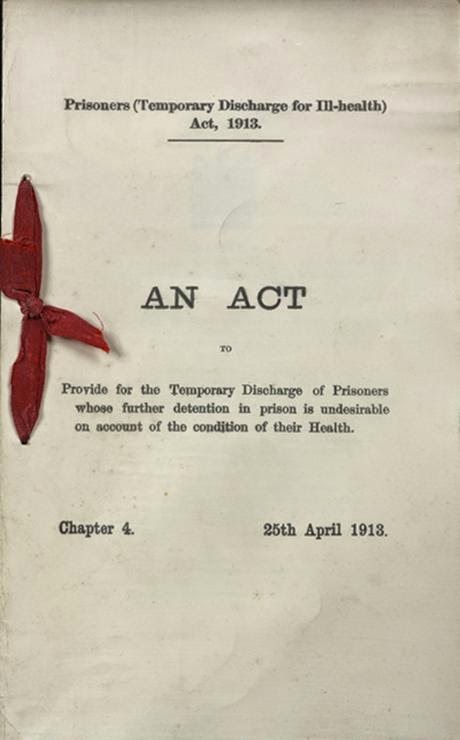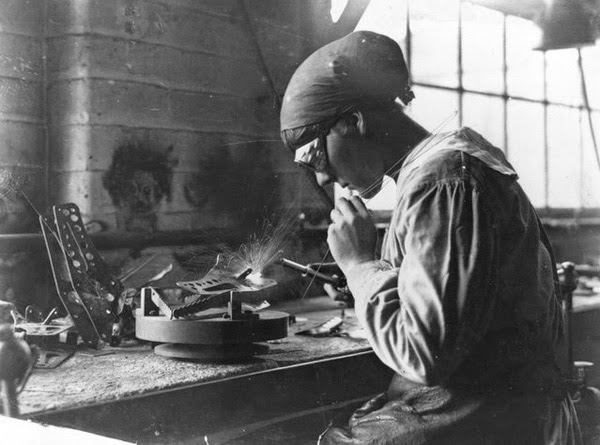Women's Social and Political Union (WSPU)
The long and arduous task faced by the members of the NUWSS when formed in 1897 in time caused dissension in the ranks amongst the group's more senior members. One particular member, Emily Pankhurst, was so frustrated by 'gradualist tactics of the NUWSS' (BBC, 2014) that she, along with other members, to form The Women's Social and Political Union in 1903. Initially joined by her eldest daughter Christabel, she was also later joined by her other daughters Sylvia and Adele (Trueman, 2013).
The members of the newly formed WSPU would be known as Suffragettes.
Below is a short biography of Emily Pankhurst:
Emmeline Goulden was born on 14 July 1858 in Manchester into a family with a tradition of radical politics. In 1879, she married Richard Pankhurst, a lawyer and supporter of the women's suffrage movement. He was the author of the Married Women's Property Acts of 1870 and 1882, which allowed women to keep earnings or property acquired before and after marriage. His death in 1898 was a great shock to Emmeline.
In 1889, Emmeline founded the Women's Franchise League, which fought to allow married women to vote in local elections. In October 1903, she helped found the more militant Women's Social and Political Union (WSPU) - an organisation that gained much notoriety for its activities and whose members were the first to be christened 'suffragettes'. Emmeline's daughters Christabel and Sylvia were both active in the cause. British politicians, press and public were astonished by the demonstrations, window smashing, arson and hunger strikes of the suffragettes. In 1913, WSPU member Emily Davison was killed when she threw herself under the king's horse at the Derby as a protest at the government's continued failure to grant women the right to vote.
In 1918, the Representation of the People Act gave voting rights to women over 30. Emmeline died on 14 June 1928, shortly after women were granted equal voting rights with men (at 21).
Emmeline Pankhurst wanted a greater commitment to women’s political rights from the ILP (Independent Labour Party). She wanted the ILP to simply state that women had the right to the same political status as men. The first primary role of the new Women’s Social and Political Union was to put pressure on the ILP. They were helped in this as a number of the members of the Women’s Social and Political Union were married to ILP members. From its start, the WSPU wanted to live by its motto: "Deeds, not words" (Trueman, 2013).
The Women’s Social and Political Union did not start out as a militant movement. In later years, former members of the WSPU claimed that the movement had been pushed into its militant stance by the intransigent behaviour of the government of the day.
In 1906, when Asquith’s Liberal Party came to power, the hopes of the WSPU were raised simply because the Liberal Party was seen as the party that would pioneer women’s political rights in Britain. The Women’s Social and Political Union believed that the Liberal Party by the very nature of liberalism would push forward political reform. When this did not happen, militancy became common place with regards to WSPU actions. In fact, militancy was not new to some members of the WSPU. Some of the older members had achieved some fame in the years before the WSPU had been formed. Dora Montefiore had urged civil disobedience in the 1890’s in the form of non-payment of taxes. In 1906, Montefiore had refused to pay her tax on the basis that "taxation without representation is tyranny". Her house was besieged for six weeks by bailiffs waiting to get out furniture valued to the amount of tax she owed. (Trueman, 2013)
Key Events of WSPU
1903
Women’s Social and Political Union (WSPU) formed in Manchester by Emmeline Pankhurst.
1905
Militant campaign begins. Christabel Pankhurst and Annie Kenney are arrested and imprisoned. Deeds not Words and Votes for Women are adopted as campaign slogans.
1906
WSPU moves to London. Liberal government returned by a landslide.
1907
Feb: ‘Mud March’- suffragist march on Parliament – so-called because of the awful weather
Women’s Parliament at Caxton Hall
Sept: Women’s Freedom League (WFL) is formed, led by Charlotte Despard, breaking away from WSPU, in response to domination of the movement by the Pankhursts as leaders, in favour of democratic and constitutional organisation and to address wider agenda of women’s issues. WFL establishes the paper The Vote
Oct: Votes for Women launched
1908
Asquith becomes Prime Minister, following resignation of Campbell-Bannerman.
June: Mass Hyde park rally
Dec: Actresses Franchise League established at meeting at Criterion Restaurant
1909
First hunger strikes by suffragettes. Forcible feeding introduced
May: Votes for Women Exhibition, Prince’s Skating Rink, Knightsbridge
Formation of the National League for Opposing Women’s Suffrage.
Dissolution of Parliament following battles over budget.
Nov: A Pageant of Great Women first performed at Scala Theatre
1910
Liberals return to power with reduced majority.
‘The Truce’ is declared – an end to militancy as Conciliation Committee promotes Suffrage Bill which passes second reading. Parliament dissolved once more following struggles between Liberal government and House of Lords.
July: Major rally in Hyde Park
Women march on House of Commons: Black Friday
1911
April: No Vote No Census protest
Record-breaking Coronation procession
Re-election of Liberal government. Further Truce with militants. New Conciliation Bill passes second reading with large majority – only to be torpedoed in November.
1912
Mass widow-smashing campaign. Labour Party supports women’s suffrage in alliance with NUWSS.
Mar: Christabel flees to Paris.
Oct: Sylvia Pankhurst establishes campaign in East End in support of George Lansbury and his candidacy in Bow and Bromley by-election
Split in WSPU as Emmeline and Frederick Pethick-Lawrence are expelled. They continue to edit Votes for Women. WSPU sets up The Suffragette.
1913
Speaker’s ruling wrecks hopes of amendment to include women in Reform Bill. Militant bomb and arson campaigns express widespread fury.
April: Cat and Mouse Act introduced – women can be temporarily released because of ill-health and then immediately re-arrested.
WSPU offices raided.
June: Emily Wilding Davis dies from injuries received on Derby Day under the hoofs of the King’s horse. Huge funeral procession held in London. Emmeline Pankhurst is arrested and goes on hunger and thirst strike.
1914
Violent action continues.
Sylvia Pankhurst’s East London Federation forced to split from WSPU because of focus on working women and her socialist links and sympathies.
4th August – War is declared. Suffrage prisoners are released
Emmeline and Christabel Pankhurst cease campaigning, support recruitment of soldiers and urge women to join the war effort.
http://www.thesuffragettes.org/history/key-events/

















